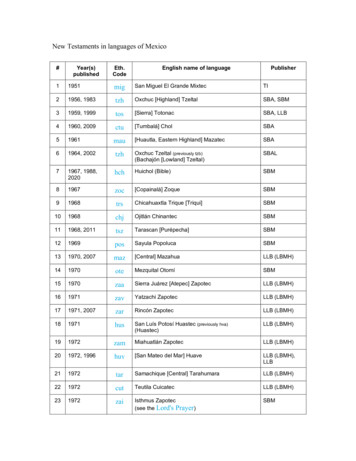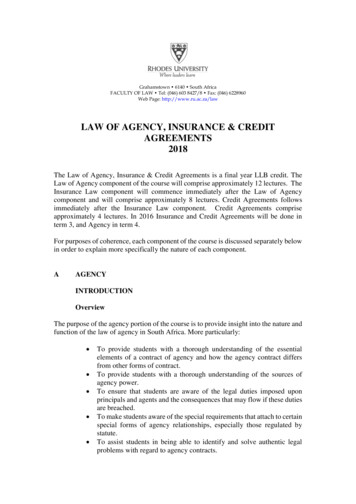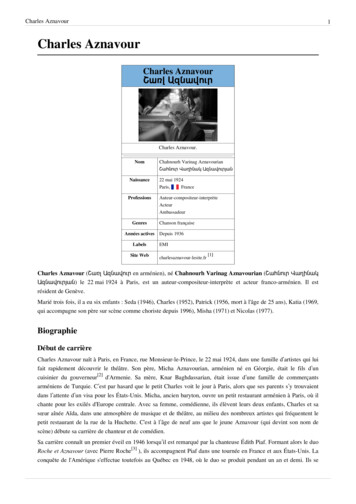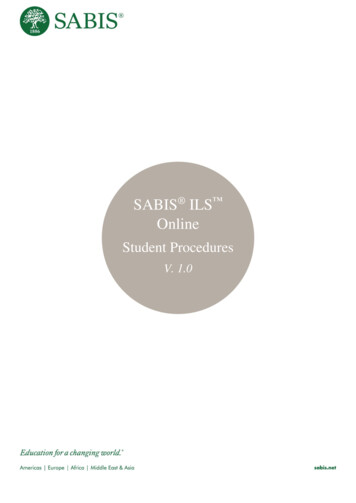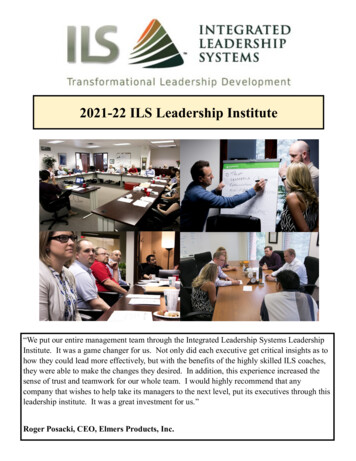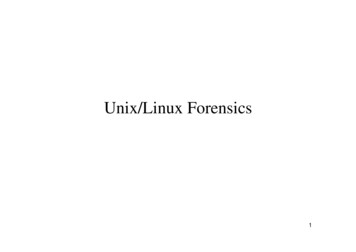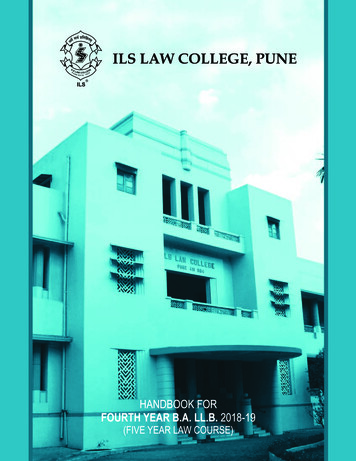
Transcription
ILS LAW COLLEGE, PUNEHANDBOOK FORFOURTH YEAR B.A. LL.B.(FIVE YEAR LAW COURSE)2018-2019
Our Mission
RulesuIt is mandatory for every student to attend atleast 75% of total lectures held in each term inthe college, as per Ordinance No. 68 of theSavitribai Phule Pune University.uStrict Disciplinary Action will be taken againststudents indulging in any kind of Raggingactivity (as defined by 'The MaharashtraProhibition of Ragging Act 1999') inside oroutside the college.uLaw courses taught in the college areProfessional Courses and Students must dressappropriately for the same. Shorts, short tops,short skirts and bermudas are not allowed.Teacher's instructions in this respect shall befollowed.uDress code for GirlslFullJeans / Trousers and TopslSalwar KameezlSareesuDress code for BoyslFullJeans / TrouserslShirts / T-ShirtsuStudents must wear Identity card aroundtheir neck.uVisit www.unipune.ac.in for examinationpattern and rules of passing.
Useful InformationCollege Timings:College Office :Working HoursLibrary Timings:Morning SessionDay Session07.15 am onwards10.50 am onwardsMon to Sat9.00 am to 4.00 pmLunch Time1.00 pm to 1.30 pm9.30 am to 9.00 pmComputer and Internet Facilities :?Computer Lab for students?Dedicated lease line for Internet Connectivity?Wi-Fi connectivity in the Library, Class Rooms and Girls’ Hostel.?Internet connectivity in Boys’ and Girls’ HostelsE-Resources provided by the Library :?AIR database including Supreme Court and all High Court Reports?Supreme Court Weekly?Criminal Law Journal?SCC on-line including reports of Supreme Court and High Courts, Privy Council, ConstiturentAssembly Debates, Law Commission Reports, International Case Laws and Statutory materials.?Manupatra on-line?Lexis Nexis on-line covering International Case Laws and Articles from 1106 International LawReviews and Journals?Lexis India on-line (e-books) providing access to electronic version of commentaries on variouslaw subjects published by Lexis Nexis?Corporate Law Adviser (CLA) on-line?West Law International?N-LIST Programme of INFLIBNET providing access to more than 9000 e-journals and 57000 ebooks.?Tax SutraCells established and working with student initiative and participation :Committees working for Students’ Welfare :?Legal Aid Centre?Gender Studies Cell?Anti-Ragging Committee?Equal Opportunity cum Enabling Cell?Grievance Redressal Committee?Human Rights Cell?Internal Committee for Prevention of?Hariyali- The Environment CellSexual Harassment?Corporate Law Cell?Internal Quality Assurance Cell?Intellectual Property Rights (IPR) Cell?Academic and Research Coordinator?Moot Court Society?Debating Society?ILS Quiz Club?Criminal Law Cell?Centre for International Law Cell?ILS History Club?ILS Literary Club?Centre for Public Law
IV BA LLB 2018-19ILS Law College, Pune 411 004Fee Structure for IV BA LLB (Five Year Law Course) : Academic Year 2018-2019Sr.No.Head of FeesIVth BALL.B. (BCStudents)IVth BALL.B.(withinState)IVth BALL.B. (outof State)IVth BA LL.B.(NRI-Bhutan,Nepal,Srilanka,BangladeshIVth BA LL.B.(NRI)1Tuition Fee020004000400060002Admission Fee0202040603Library Fee01001002003004Gymkhana Fee01001002003005Medical Fee000006Student Welfare Fund01001002003007Computerization Fee050501001508Pro Rata Contribution forAshwamegh0303060909Disaster Management02020406010 Development Fee025025050075011 Student Safety Insurance01010203012 Student Aid Fund01010203013 Registration Fee025255075020020040060015 Terminal / Tutorial Fee015015030045016 Identity Card Charges015015030045017 Magazine Fee020020040060018 Eligibility Fee0000019 NSS Fee010102030---------------000014Gathering & Prize DistributionFee20 Field Work FeeOther Activities Fees21 Debating Fee8008008001600240022 Seminar Fee1500150015003000450023 Moot Court Fee35003500350070001050024 Legal Aid 005000750027 Abhivyakti Law Journal5005005001000150028 Cultural Activities Fee2350235023504700705029 Maintenance of Equipment205020502050410061506556556551310196525 Law Review Fee26Physical Fitness (Swimming /Gymnasium)30 Research Activities
IV BA LLB 2018-19ILS Law College, Pune 411 004Fee Structure for IV BA LLB (Five Year Law Course) : Academic Year 2018-201931Training Placement & SkillsDevelopment2000200020004000600032 Barcouncil Registration10010010020030033 E-learning Equipments50005000500010000150001. Computer Lab000002. LCD (Classroom)000003. Wi-fi access000003500350035007000105001. Text Books000002. Reference Book000003. Law Reports000004. Law Journal000005. Govt. Publications (gazettes)000004500450045009000135001. E-books000002. E-journals000003. E-data bases legal0000036 Email facility1000100010002000300037 Games & 180391807406011094034 Print Resources35 Elctronic Resources38 Prospectus FeeTOTAL
SAVITRIBAI PHULE PUNE UNIVERSITYFOURTH YEAR OF THE FIVE YEAR LAW COURSE (B.A. LL.B.)SYLLABUSSEMESTER VII : JUNE - OCTOBERPaper No. SubjectsMarks21Law of Evidence10022Environmental Law including laws of Protection of100Wild Life and Other Living Creature including AnimalWelfare23Human Rights and International Law10024Arbitration, Conciliation and Alternative Disputes100Resolution SystemSEMESTER VIII : NOVEMBER – APRILPaper No.SubjectsMarks25Jurisprudence10026Property Law including Transfer of Property Act and100Easement Act27Practical – II (Public Interest Lawyering, Legal Aid100and Para Legal Services28Optional Any One100A) Comparative LawB) Insurance LawC) Conflict of LawD) Intellectual Property LawFourth Year of the Five Year Law Course1ILS Law College, Pune
SEMESTER VIIPAPER NO. 21 – LAW OF EVIDENCE – 100 MARKSThe Indian Evidence Act 1872 (With latest amendments and up-to-date case-law)1.Preliminary (Sec. 1 to 4)(Objects, Applications and Definitions)2.Evidence of facts in issue and relevant facts only (Sec. 5)3.What facts are relevant (Sec. 6 to 16)4.Admissions (Sec. 17 to 31)5.Statement by persons who cannot be called as witnesses (Sec. 32 & 33)6.Statement made under special circumstances (Sec. 34 to 39)7.Relevancy of Judgements (Sec. 40 to 44)8.Relevancy of opinions of third persons (Sec. 45 to 51)9.Relevancy of Character (Sec. 52 to 55)10.Facts which need not be proved (Sec. 56 to 58)11.Oral Evidence (Sec. 59 & 60)12.Documentary Evidence (Sec. 61 to 73A)13.Public Documents (Sec. 74 to 78)14.Presumptions as to Documents (Sec. 79 to 90-A)15.Exclusion of oral by documentary evidence (Sec. 91 to 100)16.Burden of Proof (Sec. 101 to 114-A)17.Estoppel (Sec. 115 to 117)18.Competency of Witnesses (Sec. 118 to 134)19.Examination of Witnesses (Sec. 135 to 166)20.Improper admission and rejection of Evidence (Sec. 167)Recommended Books and Readings :1. Ratanlal and Dhirajlal - The Law of Evidence2. Batuklal - The Law of Evidence3. Avtar Singh – The Law of Evidence4. Vepa Sarathy – The Law of Evidence5. Dr. Satish Chandra – Indian Evidence ActFourth Year of the Five Year Law Course2ILS Law College, Pune
SEMESTER VIIPAPER NO. 22 : ENVIRONMENTAL LAW – including laws for protection ofwild life and other living creatures and other animalwelfare – 100 MARKS1.2.Introduction –i.Nature, scope, need and application of environment lawii.Environmental pollution – causes and effectsConstitutional Provisionsi.Right to life, right to wholesome environment, right to development,directive principles of state policy, Fundamental duties, Constitutionand environmental legislationsii.3.Environment Protection and Public Interest LitigationInternational Environmental Law and Environment Protectioni.Sustainable development, Polluter-pays-principle, Precautionaryprincipleii.Salient features and critical study of Stockholm Conference on HumanEnvironment, 1972iii.Nairobi Declarations, 1982iv.Rio Conference on Environment and Development, 1972 (earthSummit) Rio Declaration Convention on Biological Diversity, The Indian BiologicalDiversity Act, 2002 4.Convention on Climate Change, 1992Environment Pollution and Laws in Indiai.Framework and analysis of anti-pollution Acts and Rulesii.Authorities under the Actsiii.Penalties and Liabilities under the Actsiv. Rules :a. Noise Pollution (Regulation & Control) Rules, 1989b. Hazardous Wastes (Management and Handling) Rules, 1989c. Manufacture, Storage and Import of Hazardous Chemical Rules, 1989d. Municipal Solid Wastes (Management and Handling) Rules, 2000e. Coastal Regulation Zone (CRZ) Notification of 19991Fourth Year of the Five Year Law Course3ILS Law College, Pune
5.Environment and Developmenti.Important environmental issues involved in the development projectslike big damsii.6.7. Silent Valley Project Tehri Dam Project Narmada Valley ProjectEnvironmental Clearance Environment Impact Assessment National Environment Appellate Authority Act, 1997Environmental Policies in Indiai.Pre-independence policy on environmentii.Post-independence policy on environmentLiability to pay compensation – No-fault liabilityi.The Public Liability Insurance Act, 1991ii. The National Environment Tribunal Act, 19958.Protection of Wild Life and Forestsi.The Wild Life Protection Act, 1972ii. The Indian Forest Act, 1927iii. The Forest Conservation Act, 1980Recommended Books and Readings :1.Bell and Bell – Environmental Law2.Resencraz and Dewan – Cases and Materials on Environmental Law andPolicy in India3.Baxi Upendra – The Bhopal Case4.Aggarwal Anil – The State of India’s Environment5.Lal’s Commentaries on Water and Air Pollution and Environment ProtectionLaws6.Pal Chandra – Environment Pollution and the Law7.Malviya – Environmental Pollution and Its Control Under International Law8.Leelakrishnan – Environmental Law, 19869.The Environment Protection Act and RulesFourth Year of the Five Year Law Course4ILS Law College, Pune
SEMESTER VIIPAPER NO. 23 : HUMAN RIGHTS AND INTERNATIONAL LAW – 100 MARKSDivision of Marks – Human Rights – 40 Marks, International Law – 60 MarksA.HUMAN RIGHTS – 40 MARKS1.Human Rights – Nature, concept, origin and development, importance,classification2.Civil and Political Rights, International Instruments – UN Charter, UDHR,International Covenant on Civil and Political Rights, Part III of the Constitutionof India3.Social and Economic Rights, International Instruments including InternationalCovenant on Economic, Social and Cultural Rights Part IV of the Constitutionof India4.Human Rights and vulnerable groups, Rights of Women, Children, Disabled,Tribals, Aged and Minorities, National and International legal developmentsPart IV A of the Constitution of India (Fundamental Duties)5.Enforcement of Human Rights, International, Regional and NationalMechanism (Legislative, Executive and Judicial) including Protection ofHuman Rights Act, 1993, NHRC, Role of Legal Profession, NGOs and MediaB.INTERNATIONAL LAW – 60 MARKS1.Introductorya. History of International Lawb. Theories of International Law as to its basisc. Codification in International Lawd. Nature, scope and present day position of International Law2.Sources of International Lawa. Treatiesb. Customsc. General Principles of International Lawd. United Nations General Assembly resolutions as a source of InternationalLawe. Non-statute, Other sources of International LawFourth Year of the Five Year Law Course5ILS Law College, Pune
3.Relationship between International Law and Municipal Law (Internal Law)a. Theoriesb. State practice with special reference to Indian Practice4.Subjects of International Lawa. State including recognition of states and government and statesuccessionb. Individualsc. International organizations and non-state entitiesd. Multinational companies and other private entities5.Jurisdiction of statesa. Territorial Jurisdictionb. Personal Jurisdictionc. Protective Jurisdictiond. Universal Jurisdiction (terrorism, hijacking, narcotics, war crimes andcrimes against peace)e. Diplomatic immunities and privilegesf.6.State immunityLaw of State Responsibilitya. Responsibility arising out of –i.Acts of State (Direct responsibility)ii. Acts of Individuals (Indirect responsibility)iii. Act of corporationiv. State responsibility for other subjects of International Lawb. Consequences of State Responsibilityc. Calvo Clause – exhaustion of local remedies7.Settlement of International Disputesa. Peaceful settlement of International disputesb. Coercive settlement of International Disputes (with reference to provisionsof the UN Charter)c. War and UN CharterFourth Year of the Five Year Law Course6ILS Law College, Pune
8.International Transactions – Treatiesa. Significance of Vienna Convention on law of treatiesb. Creation of treaty – steps involvedc. Termination, suspension and invalidation of treatiesd. Interpretation of treatiese. Retro-active effect of treaties9.International Institutionsa. Basic purposes, principles and membership of United Nationsb. Organs of United Nations – with special reference to General Assembly,Security Council and International Court of JusticeRecommended Books and Readings :1.Kapoor S.K. – Human Rights and International Law2.Agarwal H.O. – Human Rights and International Law3.Tandon M.P. – Human Rights and International Law4.Gurdip Singh – International Law5.Starke J.G. – Introduction to International Law6.Shaw Malco N. – International Law7.Iyer V.R. Krishna – Human Rights8.Chandra Upendra – Human Rights9.Diwan Paras – Human Rights and Law10.Brownlie Ian – Principles of Public International Law11.O’Connell – International Law12.Oppenheim – International Law (Vol. 1 & 2)13.Harris – Cases and Materials on International Law14.Indian Journal of International LawFourth Year of the Five Year Law Course7ILS Law College, Pune
SEMESTER VIIPAPER NO. 24 : ARBITRATION, CONCILIATION AND ALTERNATIVEDISPUTES RESOLUTION SYSTEM – 100 MARKSDivision of Marks – Arbitration & Conciliation – 50 Marks, Alt. Disputes ResolutionSystem – 50 MarksA. Arbitration and Conciliation Act, 1996Preliminary : Sec 1 – Short title, Extent and CommencementPart I : ArbitrationChapter I : Sec. 2 to 6 – General ProvisionsChapter II : Sec. 7 & 8 – Arbitration Agreement, Sec. 9 – Interim Measures by CourtChapter III : Sec. 10 to 15 - Composition of Arbitral TribunalChapter IV : Sec. 16 & 17 - Jurisdiction of Arbitral TribunalsChapter V : Sec. 18 to 27 – Conduct of Arbitral TribunalsChapter VI : Sec. 28 to 33 – Making of Arbitral Award and Termination of ProceedingsChapter VII : Sec. 34 – Recourse against Arbitral AwardChapter VIII : Sec. 35 & 36 – Finality and Enforcement of Arbitral AwardChapter IX : Sec. 37 – AppealsChapter X : Sec. 33 to 43 – MiscellaneousPart II : Conciliations – Sec. 61-81B. Alternative Models of Dispute Settlement1. Models of Dispute Settlement, Litigation versus Arbitration, Models of AlternativeDispute Resolutions, Negotiation, Conciliation, Mediation, Mini-Trial, Fast tractArbitration, Nature, Scope, Limitations and Necessity of alternative models ofDispute Resolution2. Administrative Tribunals – Art. 323 A and B3. Family Court under the Family Court Act, 19844. Consumer Council and Forums under the Consumer Protection Act, 19865. Settlement of Disputes through Lok Adalat and Lok Nyayalaya, GrassrootsJustice and Panchayat System for Resolution of DisputeFourth Year of the Five Year Law Course8ILS Law College, Pune
Recommended Books and Readings :1.Avtar Singh – Law of Arbitration and Conciliation2.Basu N.D. – Arbitration and Conciliation Act3.Johari – Commentary on Arbitration and Conciliation Act4.Krishnamurthys – Law of Arbitration and Conciliation5.Kwatra G.K. – New Arbitration and Conciliation Law of India, ComparativeStudy of Old and New6.Mathur C.C. – Arbitration and Conciliation Act, 19967.Roy P.C. – Arbitration and Conciliation Act8.Roy Chaudhari - Arbitration and Conciliation Act9.Naraya P.S. - Arbitration and Conciliation Act10.Twari O.P. - Arbitration and Conciliation Act11.Rao P.C. – Alternative Dispute Resolution : What it is and How it is12.Upendra Baxi – Crisis of the Indian Legal System, 198213.Patil B.S. – The Law of Arbitration and Conciliation14.Singh S.D. – The Law of ArbitrationFourth Year of the Five Year Law Course9ILS Law College, Pune
SEMESTER VIIIPAPER NO. 25 : JURISPRUDENCE – 100 MARKSLegal Theory and Concepts of Law1.Nature, Scope and Utility of Jurisprudence2.Nature of Law – General3.Administration of Justice, Necessity Criminal Justice and its Purpose, CivilJustice and its Purpose, Primary and Sanctioning Rights4.Sources of Law – Generala.Legislation – A Source of law, nature, Supreme legislation,subordinate legislation, Its relation with other sourcesb.Precedent – A source of law, meaning, theories, doctrine of staredecisis in India, destroying or weakening the binding force ofprecedent, ratio decidendi and obiter dicta, with relevant Indian caselawc.Custom – a sourse of law, definition, characteristics of customs5.Natural Law Theory6.Positive Theory of Law7.a.Analytical School and imperative theoryb.Pure theory of Lawc.Law as set of rules – HLA HartLegal Realisma.Americanb.Scandinavian8.Historical School of Law9.Sociological School of LawConcepts –1.Persons, the concept of legal personality, legal status of lower animals, deadmen, unborn persons, corporations and the State2.Legal Definition – Wrongs, duties, rights, characteristics of legal rights, legalrights in wider sense (Hohfeldian analysis of legal rights), kinds of legal rightsFourth Year of the Five Year Law Course10ILS Law College, Pune
3.Ownership, definition, characteristics of ownership, subject matter, kinds ofownership,4.Possession, idea, kinds, modes of acquiring possession, possession andownership, possessory remedies5.Property, meaning, kinds, theories, modes of acquiring property6.Liability, nature and kinds, theory of remedial liability, theory of penal liability,negligence, theory of strict liability, vicarious liability, measures of civil andcriminal liability7.Titles8.ObligationsRecommended Books and Readings :1.Fitzgerald P.J. – Salmond on Jurisprudence2.Dias – Jurisprudence3.Sethna M.J. – Jurisprudence4.Mahajan V.D. – Jurisprudence and Legal Theory5.Tandon M.P. – Jurisprudence6.Dhyani S.N. – Jurisprudence and Legal Theory7.Paranjape – JurisprudenceFourth Year of the Five Year Law Course11ILS Law College, Pune
SEMESTER VIIIPAPER NO. 26 : PROPERTY LAW INCLUDING TRANSFER OF PROPERTYACT AND EASEMENT ACT – 100 MARKS(With latest amendments and up-to-date case law)Division of Marks – The Transfer of Property Act, 1882 – 80 Marks, The IndianEasements Act, 1882 – 20 MarksA.The Transfer of Property Act, 1882 – 80 marks1.Preliminary – Object, application, definitions and doctrine of notice (Ss. 1-4,102-104)2.Transfer of Property by act of parties (Ss. 5-53A)3.Sale of Immovable Property (Ss. 54-57)4.Mortgages of Immovable Property (Ss. 58-98)5.Charges (Ss. 100-101)6.Leases of Immovable Property (Ss. 105-107)7.Exchanges (Ss. 118-121)8.Transfer of Actionable Claims (Ss. 130-137)B.The Indian Easements Act, 1882 – 20 Marks1.Easements (Ss. 1-51)2.Licenses (Ss. 52-64)Recommended Books and Readings :1. Sarathi V.P. – Law of Transfer of Property2. Shaha S.M. – Transfer of Property Act, 18823. Mulla on Transfer of Property Act4. Lahiri S. M. – Transfer of Property Act5. Mitra B.B. – Transfer of Property Act6. Shukla S.N. – Transfer of PropertyFourth Year of the Five Year Law Course12ILS Law College, Pune
SEMESTER VIIIPAPER NO. 27 : PUBLIC INTEREST LAWYERING, LEGAL AID AND PARALEGAL SERVICES – 100 MARKSA.Meaning and Concept of Public Interest Litigation, Development through decidedcases and Limitation, Public Interest Litigation and Writs under Article 226 and 32of the Constitution, with special reference to Environmental Protection Labour,Under Trial Prisoners, Human Rights, Protection of Women etc.B.1.Concept and Role of Lok-Nyayalaya (Lok Adalats) in India for thesettlement of disputes2.C.Constitution, Composition and Jurisdiction of Lok Adalat and AppealLegal Aid :1.Statutory Provisions relating to Legal Aid – Art. 39A of the Constitution ofIndia2.Sec. 304 of the Code of Criminal Procedure, 19733.Advocates duty to render Legal Aid4.The Legal Services Authorities Act, 1987Chapter I: Preliminary (Sec. 1 & 2)Chapter II: The National Legal Services Authority (Sec. 3 to 5)Chapter III: State Legal Services Authority (Sec. 6 to 11-B)Chapter IV: Entitlement of Legal Services (Sec. 12 & 13)Chapter VI: Lok Adalats (Sec. 19 to 22)Chapter VI A : Pre Litigation Conciliation and Settlement (Sec. 22-A to22-E)4A.The Maharashtra State Legal Services Authorities Rules, 1998, Role ofthe Legal Aid Centres in Law Colleges and Law Department of theUniversity in providing free Legal Aid and AdviceD5.Rules relating to Legal Aid for defending Accused6.Objects of Legal LiteracyAmicus Curiae – Concept and ObjectFourth Year of the Five Year Law Course13ILS Law College, Pune
ERole of Non-Government Organisation (NGO) – Protection of Human Rights,Consumers Family matters, Negotiations and CounsellingFUse of the Computer in Legal EducationGDifference between PIL and representative suits and Public Interest Litigationand Private Interest LitigationHLegal Literacy – Awareness measuresIDevelopment of Legal System from Panchayat Raj to Legal Aid by CourtsJSpeedy Justice mechanismiRights of LitigantsiiAdhoc CourtiiiMalimath Committee ReportivArticle 21 of the Indian ConstitutionRecommended Books and Readings :1.The Legal Services Authority Act, 19872.The Maharashtra State Legal Services Authority Rules, 19983.Dr. J.N. Pandey – Constitutional Law of India4.Code of Criminal Procedure, 19735.Civil Manual6.Criminal Manual7.P.S. Narayana – Public Interest Litigation8.Dr. Kailash Rai – Public Interest Lawyering, Legal Aid and Para LegalServices9.Mulla – The Indian Registration Act, 190810.The Bar Council of India Rules on Standard of Professional Conduct andEtiquette11.Awasthi – Lok Adalat : Legal Services Authorities, 198712.Jain Sampat – Public Interest Litigation13.Rao Mamta – Public Interest Litigation, Legal and Lok Adalats14.Narayan P.S. – Law Relating to Lok Adalats15.Sharma S.S. – Legal Aid to Poor16.P.M. Bakshi – Public Interest Litigation17.S.K. Sarkar – Public Interest LitigationFourth Year of the Five Year Law Course14ILS Law College, Pune
SEMESTER VIIIPAPER NO. 28 : INSURANCE LAW (OPTIONAL) - 100 MARKSDivision of MarksGeneral Principles of Insurance – 40 MarksThe Insurance Act, 1938, Public Liability Insurance Act, 1991, Personal Injuries(Compensation Insurance) Act, 1963, Insurance Regulatory and Development AuthorityAct, 1999, Life Insurance Corporation Act, 1956, and General Insurance Business(Nationalisation) act, 1972 – 45 MarksInsurance under the Motor Vehicles Act, 1988 – 15 Marks (with latest amendments andup-to-date case law)1. General Principles of Insurance – 40 Marksa. Insurance : What is insurance, Functions and benefits of Insurance, DoubleInsurance (See also 34 of the Marine Insurance Act, 1963), Re-insurance, Underinsurance, Classes of insurance – voluntary, commercial, compulsory, socialb. Risks : Insurable and other risks, Handing risks, Spreading risks, Mathematicalvalue or risks rating of risks, Extent of risk, Loss caused by insured’s own act,Commencement and duration of risk, Termination of risk, Period of risk and Timeof loss, Peril and proximate cause.c. Insurance Contracts :i.What is a contract of insuranceii.Subject matter of insurance – physical object, choice-in-action, liabilityiii.Types – Life, Property, Marine, Fidelity, Employer’s liability, MotorAccident, Railway Accident, Miscellaneousiv.Formation of an insurance contract – Sec. 23 to 26 of the MarineInsurance Act, 1963, Sec. 64VB of the Insurance Actv.Representation and warrantiesvi.Duty of disclosure, material facts, duty of insured and of insurer, breach ofduty, remedy, Ss, 19 to 22 of the Marine Insurance Act, 1963, Sec. 45 ofInsurance Act, 1938vii.Documents – Proposal, policy, slip, cover note, certificate of insuranceviii.Conditions of policy – conditions implied in a contract of insuranceconditions precedent and subsequent to validity of policy, conditionprecedent to liability of insurer, effect of breach, waiver of breachix.Indemnity extentFourth Year of the Five Year Law Course15ILS Law College, Pune
x.Assignment of policy and its effect, Sec. 38 of Insurance Act, 1938, Sec.52, 53 of the Marine Insurance Act, 1963xi.Premium calculation, Return Sec. 33, 54 of the Marine Insurance Act,1963xii.Insurance interest, contractual and statutory use when it must exist,insurance and wagering agreement Ss. 6 to 9, 16, 17 of the MarineInsurance Act, 1963d. Doctrine of Subrogation : Limits on the doctrine, rights and remedies of insured,exercise of the right, subrogation and abandonmente. Contribution : Conditions for exercise of right, methods of contribution2. The Insurance Act, 1938, Public Liability Insurance Act, 1991, Personal Injuries(Compensation Insurance) Act, 1963, Insurance Regulatory and DevelopmentAuthority Act, 1999, Life Insurance Corporation Act, 1956 and General InsuranceBusiness (Nationalisation) Act, 1972 – 45 Marksa. Insurance Act, 1938i.Terms and Definitions1. Policy Holder, Insurer, Authority2. Chief Agent, Insurance Agent, Principal Agent, Special Agent3. Insurance Company, Indian Insurance Company, Insurance CoOperative Society4. Life Insurance business, Fire insurance business, General insurancebusiness, Marine insurance business, Miscellaneous insurancebusinessii. Provisions applicable to insurers – Sec. 2C, 3, 3B, 4, 5, 6, 6A, 6AA, 10, 29iii. Assignment or transfer of policies, nominations – Sec. 38, 39iv. Licensing of agents, commission and rebates - Ss. 40, 40A, 42, 42A, 42B,42C, 43, 44v. Special Provisions – Ss. 45, 46, 47, 47Avi. Tariff Advisory Committee and Control of Tariff rates – Ss. 64U, 64UA, 64UC,64UE, 64UMvii. Provident Societies – Ss. 65, 65A, 66, 67, 69b. Public Liability Insurance Act, 1991i.Objects and Reasons for the statuteii.Sec. 2-18 Schedulec. Personal Injuries (Compensation Insurance) Act, 1963i.Objects and Reasons for the statuteFourth Year of the Five Year Law Course16ILS Law College, Pune
ii.Sec. 2 – employer, partial disablement, total disablement, wages, workmaniii.Compensation payable under the Act. Ss. 3,4,7c. Insurance Regulatory Development Authority Act, 1999i.Compensation of Authority – Ss. 4,5,8,10ii.Duties, powers and functions of the Authority – Sec. 14iii.Powers of the Authority under the Insurance Act, 1938d. Life Insurance Corporation Act, 1956i.Functions of the Corporation – Sec. 6ii.Exclusive privilege of life insurance business – Ss. 30, 30A, Opening of lifeinsurance sector to private participantsiii.Application of Insurance Act - Sec. 43(1)e. General Insurance Business (Nationalisation) Act, 1972i.Transfer of shares of Indian insurance companies – Sec. 4ii.General Insurance Corporation of India – Sec. 9, 10, 10Aiii.Functions of the General Insurance Corporation – Sec. 18iv.Exclusive privilege of carrying on general insurance business – Ss. 24, 24A,Opening of insurance sector to private participants3.a.Insurance under the Motor Vehicle Act, 1988 – 15 MarksCompulsory insurance of Motor vehicles under the Motor Vehicles Act, 1938– Public Place S. 146b.Requirement of policy and limits of liability – Sec. 147c.Duty of insurer to satisfy judgment and settlement with insured – Sec. 149,152, 155d.Information about insurance – Sec. 151, 158, 159, 160e.Certificate of insurance – Sec. 156, 157f.Liability of insurer in the case of ‘No fault liability’ hit and run motor accidentand for payment of compensation on structured formula basis – Ss. 140 –142, 161, 163, 163ARecommended Books and Readings :1.Srinivasan M.N. – Principles of Insurance Law2.Ivamy – General Principles of Insurance LawFourth Year of the Five Year Law Course17ILS Law College, Pune
SEMESTER VIIIPAPER NO. 28 : COMPARATIVE LAW (OPTIONAL) - 100 MARKS1.Comparative LawIts character, definitions, functions, objects, different phrases used to explain thismethod of study2.Origin and development of Comparative Law3.Distinction between Comparative Law andPrivate International LawPublic International LawLegal HistorySociology of Law4.Functions, value and aim of Comparative LawLaw as a science cannot limit itself within territory limits (natural and medicalscience are international and not remain domestic)Practical benefits of Comparative Lawa.As an aid to the legislatorb.As a tool of construction (interpretation of domestic law)c.As a component of legal education by adopting it in curriculum in theuniversitiesd.5.As a tool for unification of LawTypes of legal systemsDifferent grouping by different jurists1.2.a)Romanistic Familyb)Germanic Familyc)Nordic Familyd)Common Law Familya)Civil Law System / Continental Systemb)Common Law SystemFactors decisive for classify, Historical development, Mode of Legalthinking, Distinctive characters of legal institutions, choice of sources oflaw, ideology of each legal systemFourth Year of the Five Year Law Course18ILS Law College, Pune
6.Method of studying Comparative LawComparative Law as it is practiced today (process of comparison), Itsfunctionality, Imagination and discipline, Comparative must look outside the law,Choice of legal system for comparison (depends on the topic research), Build asystem, Critical evaluation of what has been discovered.7.Reference of comparison between different legal systemValue of judicial decision in civil law system and common law system, Statute lawand its importance under different legal systems, Legal system having mixedfeatures, Difference in legal terminology in various legal systems8.Comparative dimensions of a.Contracts – formation of contracts, offer and acceptance, formalrequirements, illegality and immoralityb.Torts in general, vicarious liability, strict liabilityc.Invasions against right of personalityd.Judges and courts, training and recruitment of judgese.Method of deciding casesf.Manner of writing opinions and decisions, jury trialRecommended Books and Readings :1.Zweigart an
36 Email facility 1000 1000 1000 2000 3000 37 Games & Recreation 2000 2000 2000 4000 6000 38 Prospectus Fee 0 300 300 300 300 TOTAL 33455 37180 39180 74060 110940. Fourth Year of the Five Year Law Course 1 ILS Law College, Pune SAVITRIBAI PHULE PUNE UNIVERSITY
